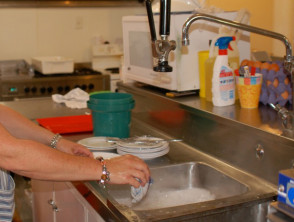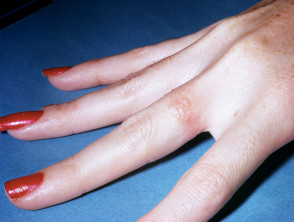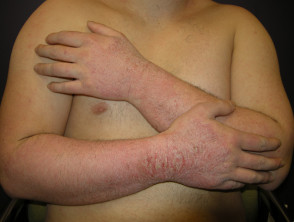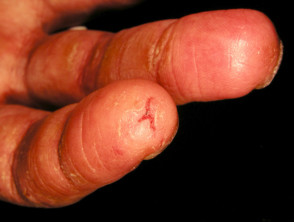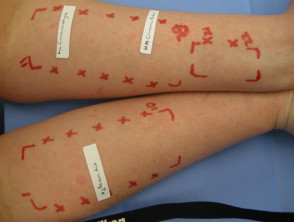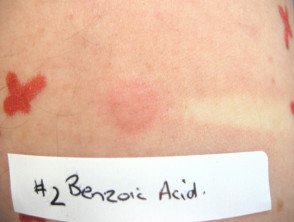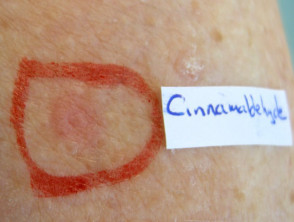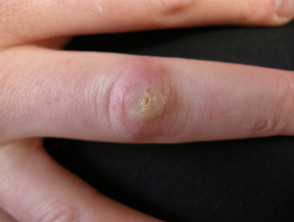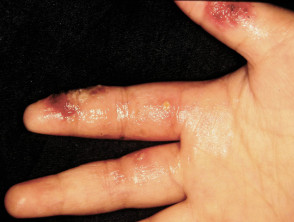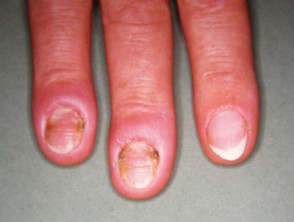Introduction
Occupational hand dermatitis in food handlers and kitchen staff is one of the main causes of ill health in the catering industry. Fifty-five per cent of all skin problems in the industry is caused by contact with water, soaps and detergents, with a further 40% of cases arising from contact with food. The number of new cases of occupational hand dermatitis every year is twice the average of other industries. Food handlers on sick leave take longer to return to work than employees who suffer skin problems in other professions. Similar problems may occur in housewives and other homemakers.
Food handlers may suffer from:
- Irritant hand dermatitis
- Allergic contact dermatitis
- Contact urticaria
- Protein contact dermatitis
- Hand infections
Typical kitchen tasks
Why do food handlers have skin problems?
Hand dermatitis in food handlers is caused by four main factors:
- Exposure to irritants e.g. repeated contact with water and detergents; prolonged glove wearing; irritating food juices
- Exposure to allergens: e.g. antimicrobial chemicals.,
- Extreme changes of environmental and surface temperature.
- Pre-existing sensitive skin or atopic dermatitis (eczema).
Wetwork
Strict hand hygiene is paramount in any food-handling situation. Food Safety Standards require food handlers to wash their hands whenever handling food to avoid contamination of the food with harmful bacteria.
A wet work occupation is one where the skin is wet for more than 2 hours a day in total, or the hands are washed more than 20 times a day.
Soaps and detergents strip the surface of the skin weakening its barrier properties.
Antimicrobial chemicals used in the food industry
Antimicrobial chemicals used in the food industry include detergents and disinfectants used in cleaning the environment and food additives used as preservatives.
Detergents and disinfectants used for cleaning and control of microbial growth fall into different classes. The following chemicals can cause severe irritation or chemical burns to the skin when used in concentrated solutions or with repeated or prolonged exposure.
- Chlorine-releasing (sodium hypochlorite)
- Iodine-based (iodophor)
- Quaternary ammonium compounds (quat)
- Peroxyacetic acid (peracetic acid)
- Acid-anionic
- Alcohols (70% isopropyl alcohol)
Chemicals used for food preservation include:
- Organic acids
- Sorbic acid
- Benzoic acid
- Calcium propionate
- Nitrates
- Antibiotics
- Aldehydes
Food irritants and allergens
Foods can be chemical or physical irritants. For example, they may be acidic, e.g. citrus fruit, or have sharp fibres, e.g. the skin of kiwifruit. Proteins in food may cause skin reactions in susceptible individuals, leading to allergic contact dermatitis or contact urticaria.
Changes in temperature
Heat may result in:
- Thermal burns
- Overhydration of the barrier layer of the skin through sweating
- Potentiation of irritant damage to the skin.
Cold may result in:
- Cold injury (frostbite, chilblains)
- Dry skin due to increased transepidermal water loss when the skin warms up, and delayed barrier recovery.
Understanding the causes of occupational skin disease
Skin damage or irritation
The outermost layer of the skin (the horny cell layer of the epidermis) acts as a barrier to prevent infection and to prevent potential allergens from penetrating the skin. Its pH is slightly acidic which can help to neutralize the degreasing agents that are in soaps, which are alkaline. Excessive use of soaps and some detergents can destroy the acidity and de-fat the surface skin and therefore reduce the protection it offers.
If the moisture content is too high (overhydrated skin) or too low (dry skin), the skin barrier may also be less effective. Natural moisturising factors are diluted and may be washed out of the skin.
Allergy
An allergy occurs when an individual's immune system comes to recognise certain harmless foreign particles or pathogens, normally harmless, as harmful. There are several types of food allergy, including:
Skin conditions in food handlers
Irritant contact dermatitis
Irritant contact dermatitis occurs when physical and/or chemical damage to the barrier layer of the skin exceeds the skin’s ability to repair the damage. Examples include:
- Repeated hand washing; and
- Exposure to cold wet conditions in the fish-processing industry.
The features of irritant contact dermatitis are varied.
- Irritant contact dermatitis may be a single episode that recovers, repeated relapsing episodes, or chronic dermatitis due to repetitive injury.
- In general, the degree of damage following irritant exposure depends on the potency of the irritant, the duration of application, the frequency of exposure, occlusion, temperature, anatomical site, and individual susceptibility.
- Where there is repeated exposure, previous damage may render the skin more susceptible to damage from the next exposure. However, hardening may also occur.
- Because contact irritant dermatitis is dose-dependent, it tends to be restricted to the site of primary contact, which is usually the hands. A reduction in the cumulative exposure to irritants lessens the risk of dermatitis. Conversely, occlusion of the irritating chemical(s) or particulates by gloves, jewellery (such as wedding rings), or wristwatch can aggravate dermatitis.
- Dermatitis may be dry, flaking, and fissuring; or red, swollen, blistering, weeping, and eroded.
- Broken skin leads to a risk of skin infection (impetigo), presenting as red, painful, swollen skin with ulceration, oozing or pustules.
Allergic contact dermatitis
Allergic contact dermatitis is an immunological response to an allergen. Only people who are allergic to a specific agent (the allergen) will show symptoms. The appearance can be exactly the same as irritant contact dermatitis. However, there are some specific features of allergic contact dermatitis:
- The allergen may have been previously tolerated for years without causing dermatitis.
- Once sensitised, the reaction may occur with minimal exposure to the allergen.
- Dermatitis may occur at the site of primary contact and also on secondary sites; e.g. a person who is allergic to rubber that wears rubber gloves may expect to get dermatitis on their hands but dermatitis may also arise on their face or neck, due to the transfer of tiny amounts of allergen by accident.
- Dermatitis occurs within hours or days of exposure to the allergen.
- Symptoms settle down when the skin is no longer in contact with the allergen, although this may take weeks and require treatment.
- Allergic contact dermatitis can usually be confirmed by patch tests.
- There is no cure, so avoiding exposure is the only way to avoid further episodes.
Nickel allergy is the most common form of allergic contact dermatitis in food handlers and others.
- Approximately 11% of all adult women are nickel sensitive. Nickel allergy is less common in males.
- Dermatitis arises at sites of contact with wristwatches, earrings and other jewellery, and with nickel-releasing tools at work.
- When stainless steel utensils, machinery and surfaces used in the preparation of food are exposed to acidic foods, water or humid conditions, the nickel leaches out of the metal.
- Some foods are known to be particularly high in nickel and include chocolate, salmon, nuts and grains, many fruits and vegetables and multivitamins.
- The wearing of jewellery whilst at work should be discouraged, and any tools/utensils should be nickel-free if possible.
Other common contact allergens that food handlers are exposed to include:
- Rubber accelerators in rubber gloves
- Food preservatives
- Fragrances and perfumes
- Naturally occurring chemicals in foods such as mangos and figs or garlic, onions and many other plants.
Allergic contact dermatitis
Contact urticaria
Contact urticaria occurs more rapidly than contact dermatitis. Following contact with the causative agent, the skin releases a chemical called histamine, causing itchy wheals (skin swelling) at the site of contact. These fade away within minutes to hours.
Contact urticaria may be non-immunological due to the release of vasoactive substances; immunological, i.e. an allergy response, where IgE antibodies are involved, and where the reaction may be generalised rather than limited to the site of contact; or a reaction of an uncertain mechanism.
Many raw foods can cause contact urticaria, including:
- Vegetables: carrots, onion, garlic, celery
- Fruits and Nuts: kiwifruit, bananas, tomatoes, berries and tree nuts (e.g. cashew)
- Legumes: peanuts
- Fish and shellfish: shrimp, lobster and crab
- Food preservatives, additives, emulsifiers, flavourings and fragrances
- Meat: commonly beef, pork and processed meats
- Dairy products: milk, cream and cheese
- Eggs
- Spices: cinnamon, vanilla, paprika and mace
- Herbs: mint, parsley, chives and thyme
- Bakery products: wheat and soy. Bleach (ammonium persulfate)
Contact urticaria to latex in rubber gloves is an immunologically mediated contact urticaria.
There are some specific features of contact urticaria.
- The rash occurs within a few minutes to one hour after exposure.
- Wheals may be localised to the site of contact, or occasionally, generalised over the whole body.
- Severity can range from mild to severe.
- Usually, symptoms disappear within one hour, and nearly always within 24 hours.
- Contact urticaria can be confirmed by prick testing, or variations on this such as scratch-patch testing, or by RAST testing if the response is immunologically mediated, e.g. latex.
Contact urticaria testing
Protein contact dermatitis
Protein contact dermatitis is more common in atopic patients. It presents as a combination of early contact urticaria and delayed contact dermatitis, and may follow repetitive contact with meat or fish proteins. It may manifest as hand dermatitis, fingertip dermatitis or chronic paronychia, with or without weals or microvesicles, within an hour of exposure to the causative agent. Protein contact dermatitis is relatively common in fish processing plants, and in abattoirs (where it is usually seen in workers who cut the animals’ throats and in those who handle the gut).
Hand infection
Bacterial infection (impetigo, boils and folliculitis) is usually caused by Staphylococcus aureus and Streptococcus pyogenes.
Food handlers with bacterial skin infections should remain on leave until the infection has resolved, to avoid bacterial contamination of the food
Hand dermatitis and wet work also predispose to yeast infection, usually presenting as chronic paronychia infected by Candida albicans, or as intertrigo between the fingers (also called erosio interdigitalis blastomycetica).
Workers in the meat, poultry and fish processing industries have an increased risk of warts, with human papillomavirus type 7 being responsible for the excess.
Skin infections in food handlers
Mechanical injuries
Thermal burns from hot oil or fluids are particularly hazardous for food handlers. Steam from opening oven doors or taking lids from saucepans can cause scalds to hands, forearm or face.
Knife cuts are common in the food industry, usually affecting the non-knife hand and fingers. A chain mail or cut-resistant glove is recommended for the non-knife hand when boning meat.
Workplace risk assessment
Workplace risk assessments identify ‘hazards’ (anything that has the potential to cause harm) and ‘risk’ (the likelihood of an event occurring). The aim should be to reduce these, as sickness absence from work can be prolonged and costly. Ill health can adversely affect the quality of life; the ability to work in a chosen industry; insurance costs and litigation claims. A generic risk assessment in any catering establishment and should include a specific section on skin exposure and should cover:
- Hazardous properties and adverse health effects of wet work
- Hazardous properties and adverse health effects from the exposure to chemicals
- Adverse health effects from the exposure to food
- Frequency and duration of exposure
- Controls and their effectiveness
- Personal protective equipment
- Staff education and training, including familiarity with the Material Safety Data Sheets for chemicals used in the workplace.
Results of the risk assessments must be recorded and kept.
Health surveillance
Health surveillance should be carried out when a workplace hazard is minimised rather than eliminated. Employees should be encouraged to report any signs of skin problems and all reasonable steps should be taken to resolve the problem and prevent recurrences. This may involve a referral for medical advice.
Personal protective equipment — gloves for food handlers
When hazards in the food industry cannot be eliminated, the use of personal protective equipment such as gloves, face masks and overalls must be considered.
When exposure to wet work, chemicals and foods cannot be avoided, the wearing of personal protective equipment such as gloves, face masks and overalls must be considered.
Disadvantages of gloves
- Gloves can be inconvenient to use especially when they extend over the fingertips as they reduce the dexterity required to prepare food.
- Prolonged glove wearing can result in irritant dermatitis.
- Contact allergy to glove constituents may develop.
Advantages of gloves
- Gloves protect the individual from contact with irritants and allergens.
- They prevent cross-infection for co-workers and the consumer.
How to wear gloves
To maximise the benefits and minimise the disadvantages of gloves they should be:
- Task-specific;
- Disposable and single-use gloves for food handling, and reusable gloves for general cleaning;
- Worn only on clean dry skin but never continuously;
- Fit for purpose, well-fitting and offered in different sizes;
- Gauntlet type for cleaning in order to cover the wrist and prevent splashes down inside the glove;
- Washed and rinsed after every use and a separate pair issued to each employee to reduce cross-infection (in the case of re-usable gloves);
- Made from nitrile, vinyl or polyethene materials, as they are less likely to cause allergy compared to rubber.;
- Worn over white cotton gloves if practicable;
- Removed safely to avoid contamination; and
- Avoided in circumstances where they could get caught on moving machinery.
Good hand care advice for food handlers
Do Not
- Allow repeated or prolonged contact with water;
- Allow repeated or prolonged contact with irritating chemicals on the skin;
- Allow the skin to come into contact with contaminated work surfaces, gloves, towels tools etc;
- Allow the skin to come into contact with contaminated dishwashing water, as the composition of the original solution will change as more debris is added;
- Wear rubber/vinyl/nitrile/polyethene gloves for more than 30 minutes at a time;
Do
- Wear gloves when carrying out wet work unless this is impractical, or glove-wearing constitutes a greater safety risk than the wet work;
- Wear gloves when working with substances including food that can cause dermatitis unless this is impractical, or glove-wearing constitutes a greater safety risk than the substances in question;
- Avoid handling food where possible — use food processors for chopping, mixing and kneading, and utensils such as tongs and scoops;
- Avoid contact with cleaning products and water where possible — consider alternative methods of cleaning such as a dishwasher;
- Look for products that have lower concentrations of harsh chemicals and are less harmful to the skin;
- Avoid wearing hand and wrist jewellery whilst at work;
- Dry hands thoroughly with soft cotton or paper towel — pay particular attention to fingertips, webs and wrists;
- Moisturise hands often, using non-perfumed moisturising creams that will not contaminate or taint food, paying particular attention to fingertips, interdigital space and wrists especially before and after work;
- Always add detergents and disinfectant to the water, never the other way around;
- Check skin regularly for signs of dermatitis;
- Report skin problems to your employer who may need to refer you for medical advice.
Treatment of occupational skin disease
If a food handler has developed hand dermatitis, they may be advised to:
- Minimise contact with irritants (water, detergents etc.)
- Avoid known allergens — identifying these will require a full history of the work and appropriate allergy tests
- Optimise skin barrier function with suitable emollients, barrier and moisturising creams applied frequently during work and at home
- Apply potent topical corticosteroids to dermatitis flare-ups
- Take antibiotics for secondary infection.
